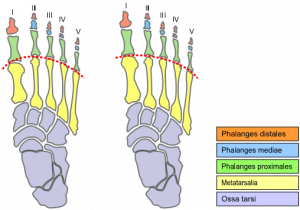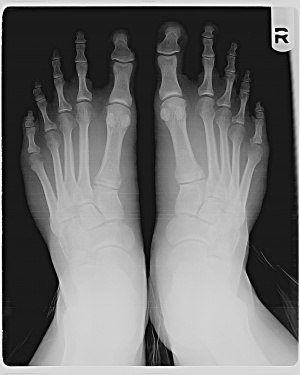Morton's Toe: Difference between revisions
No edit summary |
No edit summary |
||
| Line 10: | Line 10: | ||
== Introduction == | == Introduction == | ||
A Morton’s toe otherwise called Morton's foot or Greek foot or Royal toe, is characterized by a longer second toe.This is because the first metatarsal, behind the big toe, is short compared to the second metatarsal, next to it. The longer second metatarsal puts the joint at the base of the second toe (the second metatarsophalangeal or MTP joint) further forward.<ref name="brage">Schimizzi, A; Brage, M (September 2004). "Brachymetatarsia". ''Foot Ankle Clin'' '''9''' (3): 555–70, doi:10.1016/j.fcl.2004.05.002. PMID 15324790.</ref> | A Morton’s toe otherwise called Morton's foot or Greek foot or Royal toe, is characterized by a longer second toe.This is because the first metatarsal, behind the big toe, is short compared to the second metatarsal, next to it. The longer second metatarsal puts the joint at the base of the second toe (the second metatarsophalangeal or MTP joint) further forward.<ref name="brage">Schimizzi, A; Brage, M (September 2004). "Brachymetatarsia". ''Foot Ankle Clin'' '''9''' (3): 555–70, doi:10.1016/j.fcl.2004.05.002. PMID 15324790.</ref> | ||
Morton's toe is a little misleading, because this condition is not really a long toe, meaning the phalanges (toe bones). It is the relative length of the Metatarsal foot bones, specifically the relative length difference between the first and second that defines this foot shape.<ref name="aka">Morton's Toe. <nowiki>http://www.mortonstoe.com/</nowiki> [last accessed 27/6/2018].</ref> | |||
<br> | <br> | ||
| Line 16: | Line 18: | ||
[[Image:Mortons Toe XRay.jpg|thumb|right|X-ray image of a patient with Morton's toe.]] | [[Image:Mortons Toe XRay.jpg|thumb|right|X-ray image of a patient with Morton's toe.]] | ||
== History | == History == | ||
The name derives from American orthopedic surgeon Dudley Joy Morton (1884–1960),[2] who originally described it as part of Morton's triad (a.k.a. Morton's syndrome or Morton's foot syndrome) a congenital short first metatarsal bone, a hypermobile first metatarsal segment, and calluses under the second and third metatarsals.<ref name=" | The name derives from American orthopedic surgeon Dudley Joy Morton (1884–1960),[2] who originally described it as part of Morton's triad (a.k.a. Morton's syndrome or Morton's foot syndrome) a congenital short first metatarsal bone, a hypermobile first metatarsal segment, and calluses under the second and third metatarsals.<ref name="brage" /> | ||
<br> | <br> | ||
== | == Aetiology == | ||
= | <span>In my opinion heredity is the major causes for having foot problems. When someone says that you look like your mom or dad, bear in mind that the resemblances can also extend to how your feet look and act. It is not unusual for me to examine three generations of one family only to see the Morton’s Toe, or other similar foot problems, are present in all three generations.<ref name="burton">Burton Schuler. Foot Care for You. <nowiki>http://www.footcare4u.com/mortons-toe-what-is-it-what-causes-it-how-to-treat-it/</nowiki> [last accessed 27/6/2018].</ref></span> Morton's toe leads to excessive pressure on the second metatarsal head (behind the second toe at the ball- of-the-foot) resulting in pain similar to the discomfort associated with [[Metatarsalgia]]. The constant pressure placed on the longer second toe while walking or standing can lead to callus formation under the second metatarsal head due to this excessive pressure. | ||
== Associated Problems: == | |||
<span>This foot structure is known to cause and perpetuate musculoskeletal problems. Problems start with the feet and the list is long.</span> | |||
*'''Lower Extremity Pain''' | '''Foot Pain''' | ||
* Metatarsalgia (ball-of-foot pain) | |||
* Morton's Neuroma | |||
* Metatarsal Stress Fractures | |||
* [[Plantarfasciitis]] | |||
* Calluses | |||
* Bunion Hammer, Claw and Mallet toes | |||
<br>'''Lower Extremity Pain''' | |||
* Ankle Pain - Weak Ankles | |||
* Shin splints | |||
* Tight, Sore and Tired Calf Muscles | |||
* Knee pain | |||
*' | * Tight IT Bands | ||
* Runner's Knee (Chondromalacia) | |||
* Fractured Meniscus | |||
* ACL Tears | |||
Scoliosis & Kyphosis | * Sciatica Pain | ||
* Arthritis | |||
<br>'''Back and Neck''' | |||
* Scoliosis & Kyphosis | |||
* SI Joint Pain | |||
* Sciatica (Piriformis Syndrome) | |||
* Low-Back Pain | |||
* Upper Back and Shoulder Pain | |||
* Neck Pain (head forward posture)<br> | |||
<br>Morton's Toe impacts the whole body because it changes your posture and the way you walk and run..the second metatarsal head destablize the foot during push-off phase gait.this cause foot pronation and internal rotation of lower limb.consquently the piriforms muscle which is an external hip rotator,will contract repeadtly,during each push-off the gait cycle.it can predispose to developing piriforms syndrom.<ref name="shah">Shah S,Wang TW. Piriformis syndrome. eMedicine specialities :Sports medicine : hip 2009fckLRhttp://emedicine.medscape.com/article/87545-overview</ref><ref name="klein">Klein MJ. Piriformis syndrome. eMedicine Specialities :Physical Medicine and Rehabilitation :Lower limb Musculoskeletal conditions 2010 fckLRhttp://emedicine.medscape.com/article/308798-overview</ref> | |||
== Treatment: == | == Treatment: == | ||
| Line 54: | Line 76: | ||
== Reference: == | == Reference: == | ||
<references /> | |||
[[Category:Foot]][[Category:Foot_and_Ankle_Conditions]] | [[Category:Foot]][[Category:Foot_and_Ankle_Conditions]] | ||
Revision as of 12:51, 27 June 2018
Original Editor - Marlies Verbruggen
Top Contributors -Andeela Hafeez, Marlies Verbruggen, WikiSysop, Edema Emmanuel, Kim Jackson, Admin, Joao Costa, Richard Benes and Chrysolite Jyothi Kommu
Introduction [edit | edit source]
A Morton’s toe otherwise called Morton's foot or Greek foot or Royal toe, is characterized by a longer second toe.This is because the first metatarsal, behind the big toe, is short compared to the second metatarsal, next to it. The longer second metatarsal puts the joint at the base of the second toe (the second metatarsophalangeal or MTP joint) further forward.[1]
Morton's toe is a little misleading, because this condition is not really a long toe, meaning the phalanges (toe bones). It is the relative length of the Metatarsal foot bones, specifically the relative length difference between the first and second that defines this foot shape.[2]
History[edit | edit source]
The name derives from American orthopedic surgeon Dudley Joy Morton (1884–1960),[2] who originally described it as part of Morton's triad (a.k.a. Morton's syndrome or Morton's foot syndrome) a congenital short first metatarsal bone, a hypermobile first metatarsal segment, and calluses under the second and third metatarsals.[1]
Aetiology[edit | edit source]
In my opinion heredity is the major causes for having foot problems. When someone says that you look like your mom or dad, bear in mind that the resemblances can also extend to how your feet look and act. It is not unusual for me to examine three generations of one family only to see the Morton’s Toe, or other similar foot problems, are present in all three generations.[3] Morton's toe leads to excessive pressure on the second metatarsal head (behind the second toe at the ball- of-the-foot) resulting in pain similar to the discomfort associated with Metatarsalgia. The constant pressure placed on the longer second toe while walking or standing can lead to callus formation under the second metatarsal head due to this excessive pressure.
Associated Problems: [edit | edit source]
This foot structure is known to cause and perpetuate musculoskeletal problems. Problems start with the feet and the list is long.
Foot Pain
- Metatarsalgia (ball-of-foot pain)
- Morton's Neuroma
- Metatarsal Stress Fractures
- Plantarfasciitis
- Calluses
- Bunion Hammer, Claw and Mallet toes
Lower Extremity Pain
- Ankle Pain - Weak Ankles
- Shin splints
- Tight, Sore and Tired Calf Muscles
- Knee pain
- Tight IT Bands
- Runner's Knee (Chondromalacia)
- Fractured Meniscus
- ACL Tears
- Sciatica Pain
- Arthritis
Back and Neck
- Scoliosis & Kyphosis
- SI Joint Pain
- Sciatica (Piriformis Syndrome)
- Low-Back Pain
- Upper Back and Shoulder Pain
- Neck Pain (head forward posture)
Morton's Toe impacts the whole body because it changes your posture and the way you walk and run..the second metatarsal head destablize the foot during push-off phase gait.this cause foot pronation and internal rotation of lower limb.consquently the piriforms muscle which is an external hip rotator,will contract repeadtly,during each push-off the gait cycle.it can predispose to developing piriforms syndrom.[4][5]
Treatment:[edit | edit source]
Proper treatment of Morton's Toe starts with selecting proper footwear. Footwear with a high and wide toe box (toe area) is ideal for treating this condition. It may be necessary to buy footwear a half size to a size larger to accommodate the longer second toe. Orthotics that feature arch support to keep the foot aligned, and a metatarsal pad to reduce stress on the ball-of-the-foot are often recommended when treating this condition. Proper footwear combined with a effective orthotic will provide relief from pain associated with Morton's Toe.
If you're not comfortable showing your toes, wear socks or slippers while indoors or trainers and other closed-shoes while outdoors.Make your feet look and feel good! Just because your toe is longer, doesn't mean it can't be pampered! Paint your toe nails with nail polish and keep your feet clean. This will make your feet look and feel good![6]
Failed to load RSS feed from http://www.ncbi.nlm.nih.gov/pubmed/23649839: Error parsing XML for RSS
Recent Related Research (from Pubmed)[edit | edit source]
Reference:[edit | edit source]
- ↑ 1.0 1.1 Schimizzi, A; Brage, M (September 2004). "Brachymetatarsia". Foot Ankle Clin 9 (3): 555–70, doi:10.1016/j.fcl.2004.05.002. PMID 15324790.
- ↑ Morton's Toe. http://www.mortonstoe.com/ [last accessed 27/6/2018].
- ↑ Burton Schuler. Foot Care for You. http://www.footcare4u.com/mortons-toe-what-is-it-what-causes-it-how-to-treat-it/ [last accessed 27/6/2018].
- ↑ Shah S,Wang TW. Piriformis syndrome. eMedicine specialities :Sports medicine : hip 2009fckLRhttp://emedicine.medscape.com/article/87545-overview
- ↑ Klein MJ. Piriformis syndrome. eMedicine Specialities :Physical Medicine and Rehabilitation :Lower limb Musculoskeletal conditions 2010 fckLRhttp://emedicine.medscape.com/article/308798-overview
- ↑ http://www.wikihow.com/Deal-With-Morton's-Toe








